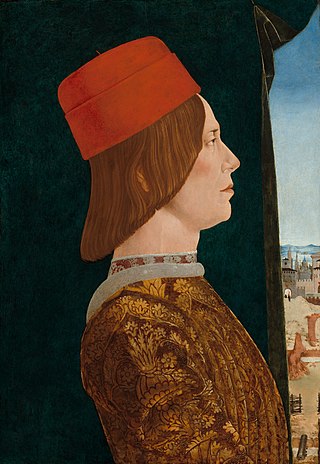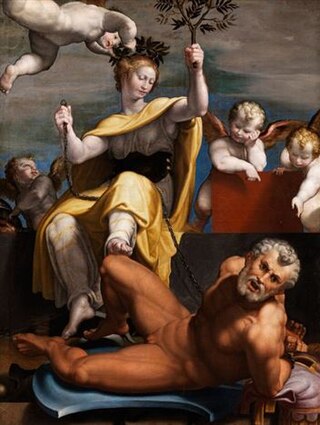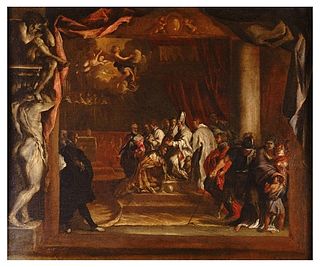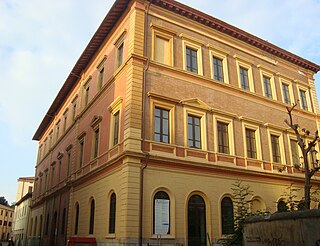
The original Palazzo Bentivoglio was a palace in Bologna, which was destroyed by a mob in 1507. A second palace by the same name was built nearby, and is still standing.

The original Palazzo Bentivoglio was a palace in Bologna, which was destroyed by a mob in 1507. A second palace by the same name was built nearby, and is still standing.
The palace of the noble Bolognese family of Bentivoglio was built on the orders of Sante Bentivoglio, in Via San Donato (today Via Zamboni), starting in 1460, and was subsequently completed by Giovanni II Bentivoglio. Contemporary chroniclers and scholars have attempted to reconstruct the appearance of the great house on the basis of often enthusiastic descriptions. The main facade facing onto Via San Donato measured 30 meters, while the sides were over 140 meters in length. Located on the ground floor were the apartments of the men of the house of Bentivoglio, while the upper floor held the apartment of Giovanni II, richly frescoed, and the equally sumptuous apartment of Ginevra Sforza and the other women of the house. The building also housed guards and soldiers and included guest rooms, warehouses and depots of arms. The building had 244 rooms in total. In it, the Bentivoglio received illustrious visitors and friends, and hosted extravagant dinners and parties. [1]
The building was destroyed by popular fury in the spring of 1507. The decision to destroy it was made by the enemies of the Bentivoglio family, who had come to see their rule of Bologna as tyrannous and had co-operated with Pope Julius II to bring about their expulsion from the city in late 1506. The city's new rulers were convinced that it was necessary to raze the house of tyrants if you wanted to prevent their return, and the Senate accordingly decreed that any emblem or sign of the Bentivoglios' past domination must be destroyed. The destruction of the palace in Via San Donato was, however, a great loss for the history of Italian art. [1] Today the area where the palace stood is occupied by the Teatro Comunale, adjacent to Via del Guasto ("Ruin Road"), whose name recalls the fate of the Bentivoglio palace. The modern Giardino del Guasto, a small public garden created in 1975 by the architect Rino Filippini, covers the area formerly occupied by the garden of the palace.
A little further on, in Via Delle Belle Arti, stands the imposing new Palazzo Bentivoglio. It was built, starting in 1551, by Costanzo Bentivoglio, a descendant of a collateral branch (non-dominant) of the family.[ citation needed ] The architect Bartolomeo Triachini is attributed with the design of the majestic and beautiful later palace. The entrance leads into a spacious courtyard surrounded by a double loggia that was based on designs by Domenico Tibaldi. It was completed by Giovanni Battista Falcetti in the first half of the seventeenth century. The upper floor of the new palace has a number of halls that have ceilings and friezes from the Tibaldi school. There is a large gallery painted by in chiaroscuro style Antonio Bonetti with sculptures by Ubaldo Gandolfi. The gallery was opened in 1769 when senator Fulvio Bentivoglio became Gonfaloniere of Bologna. [2]
Citations
Sources
Further reading

Cento is a town and comune in the province of Ferrara, Emilia-Romagna, Italy.

Ginevra Sforza became the wife of Sante Bentivoglio and then of Giovanni II Bentivoglio, both de facto signori of Bologna. She had 18 children and served the Bentivoglio family by fulfilling the gendered role demanded of her by society.
Sante I Bentivoglio was an Italian nobleman who ruled as tyrant or de facto prince of Bologna from 1445 to 1462.

Giovanni II Bentivoglio was an Italian nobleman who ruled as tyrant of Bologna from 1463 until 1506. He had no formal position, but held power as the city's "first citizen." The Bentivoglio family ruled over Bologna from 1443, and repeatedly attempted to consolidate their hold of the Signoria of the city.

The Bentivoglio Altarpiece is a painting by the Italian Renaissance painter Lorenzo Costa, dating to August 1488. It is displayed in the Bentivoglio Chapel of the church of San Giacomo Maggiore, Bologna, Italy.

The Basilica of San Giacomo Maggiore is an historic Roman Catholic church in Bologna, region of Emilia Romagna, Italy, serving a monastery of Augustinian friars. It was built starting in 1267 and houses, among the rest, the Bentivoglio Chapel, featuring numerous Renaissance artworks.

Domenico Tibaldi was an Italian architect and painter. He was a major exponent of the Bolognese Mannerist style

Jacopo di Paolo was an Italian painter and miniaturist active in Bologna in the fourteenth and fifteenth centuries.

The Palazzo Poggi is a palazzo in Via Zamboni 33, Bologna, Italy. It is the headquarters of the University of Bologna and of the rector of the university.
Bartolomeo Triachini or Bartolomeo Tassi (1516–1587) was a Bolognese architect.

Domenico Pedrini was an Italian painter. Fiercely provincial in his geographic activity, Pedrini's works were mainly completed in and around Bologna, and yet his atavistic style strayed far afield into Bologna's strong Baroque ancestry.

The Palazzo Legnani Pizzardi, also known as Palazzo Pizzardi e Volta or just Palazzo Pizzardi, is a Renaissance style palace located on Via d'Azeglio #38, corner with Via Farini, in central Bologna, Italy. In 2015, the palace housed the Tribunal of Bologna.

The Palazzo Torfanini is a Renaissance architecture palace located on Via Galliera 4, in central Bologna. It is located near the Palazzo Aldrovandi. The palace, with typical facade arcades, was commissioned by Bartolomeo Torfanini in 1544.

The Palazzo della Compagnia dell'Arte dei Brentatori is a medieval palace located on Via de' Pignattari #11, starting at the Piazza Maggiore and running alongside the basilica church of San Petronio. It presently functions as the Hotel Commercianti, and a hotel at the site has existed for over a century.

The Piazza di Porta Ravegnana is a city square in the central of Bologna, region of Emilia-Romagna, Italy. The Piazza, located some four blocks east of the Piazza Maggiore and Cathedral of Bologna, is the site of the Two Towers of Bologna.

The Palazzo Malvezzi de' Medici is a Renaissance-style palace located on Via Zamboni #13 in central Bologna, Italy. The palace now houses the offices of the Provincial Administration.

Charles V was crowned Holy Roman Emperor by Pope Clement VII in the San Petronio Basilica in Bologna on 24 February 1530. He was the last Holy Roman Emperor to be crowned by a pope. The emperor was also crowned King of Italy on 22 February, also the last coronation of an Italian king by a pope.

The Arese are a prominent family of the Milanese nobility.
The Palazzo Vizzani Lambertini Sanguinetti, sometimes known merely as Palazzo Vizzani, is a Renaissance palace located on Via Santo Stefano #43 in the center of Bologna, region of Emilia-Romagna, Italy. Presently the palace houses the faculty of Foreign Languages and Literature of the University of Bologna.

Palazzo Mensini is a palace in the historic center of Grosseto, Tuscany.